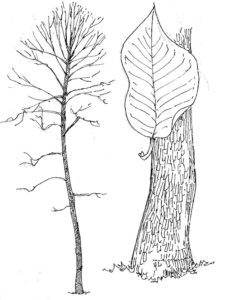The Rodney Dangerfield Tree of Buffalo River Ledges

Illustration is a profile of the mature tree found growing in Boen Gulf. The leaves are thin and supple “shade leaves” from an understory sapling.
Many Ozark hikers are familiar with the common trees such as oak, beech, black gum, and hickory that make up our scenic upland hardwoods. Other trees such as sycamore, sweetgum, and river birch are notable for the way they line our waterways. But one important Ozark tree, like that famous comedian of old, just cannot get any respect.
Exactly how important the cucumber magnolia (Magnolia acumenata) is in our forests was revealed by a recent study. The significance of this unassuming tree was demonstrated in a dendrochronological study completed as part of a University of Arkansas student Master’s thesis. The project selected a remote and inaccessible gorge in the upper Buffalo drainage as a location where the difficult access by loggers could have allowed the trees there to escape logging.
These trees just might represent a fragment of virgin Ozark forest and the student’s tree ring study was designed to test that hypothesis. The remoteness of the study site is indicated by the fact that the student had to rappel down the face of a sandstone cliff just to get to his project.
An inventory of trees on this particular study site showed that cucumber magnolia was not only common, but actually the most abundant of all trees in the sampled area.
When you take the time to look at the forest around you on a hike into the scenic tributary gorges to the buffalo, you can see that this is not a fluke. Cucumber magnolia is consistently as common as the other trees like oak and beech you expect to see in such sheltered locations. It’s just that the cucumber tree is so non-descript. It does not grow especially big and does not attain the impressive diameter of some oaks and beeches.
The tree has rather plain-looking bark with a medium brown color and a rather ordinary texture of shallow vertical ridges. The bark is so plain just because it does not provide a very good foothold for the mosses and lichens that add so much interest to the bark of trees such as beech and oak. The leaves are nearly as large as the leaves of the oaks, but are simply oval with pointed tips.
The leaves are shed completely in the fall and not retained in a brown and shriveled form such as happens with many oaks. Thus, the cucumber tree canopy blends in with all of the other bare-branched deciduous trees in the winter when forest vistas open up to long-distance view.
Magnolias are noted for showy flowers and many related species are planted as ornamentals. But not the cucumber tree. It has small (for a magnolia), greenish-white blossoms that are hidden high in the canopy.
The cucumber tree gets its name from the fist-sized seed pods it produces, which some people compare to a warty and misshapen cucumber. According to the Department of Commerce’s Silvics handbook, cucumber tree wood is so similar to that of the better-known tulip poplar that its timber is marketed along with the more abundant wood from that tree. The preference of cucumber tree for cool and moist habitats means that it is not otherwise common in the logging industry even if it is locally abundant in hard to access gorges and ravines such as those around the Buffalo River. Thus, this important component of our Buffalo River ecosystem really doesn’t get the respect it deserves.
Where would be a good place to see the cucumber magnolia in its natural habitat – without having to rappel down a ledge as was required for the University of Arkansas study? You can look down into one of these steep, inaccessible ravine-slope forests by following the Buffalo River Trail upstream from the Ponca low water bridge. The trail is steep but follows the crest of the ascending ridge with views into the old growth forest off to your left as you work your way uphill. Look for the oval, leathery magnolia leaves underfoot and then look up to see the unassuming source of those leaves. The cucumber magnolia is so plain and nondescript that it is best identified by not being an oak, hickory, beech or ash. A tree so plain that you end up identifying it by what it isn’t!

Detail of cucumber tree foliage superimposed on a low-water view of the upper Buffalo River area. The stiff and leathery leaf above is a “sun leaf” fallen from the top of the tree.
